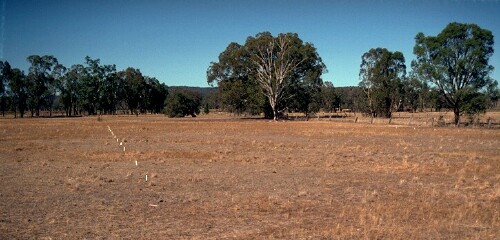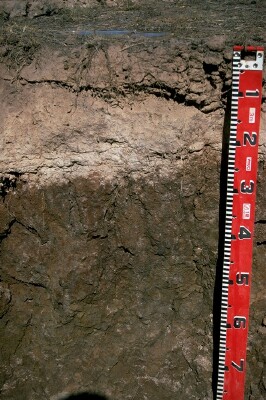NE2
| Group: Chiltern Landcare Group | Australian Soil Classification: Eutrophic, Mottled-Subnatric, Grey SODOSOL |
| Northcote Factual Key: Dy 3.43 | Great Soil Group: solodic soil |
| General Landscape Description: Old alluvial plain. The original vegetation includes Blakely's Red Gum (Eucalyptus blakelyi), Yellow Box (E. melliodora) and Grey Box (E. microcarpa) | |
 NE2 landscape |
Soil Profile Morphology:
Surface Soil
| A1 | 0-10 cm | Dark yellowish brown (10YR4/4); fine sandy loam; hard setting and massive surface condition; earthy fabric; firm consistence dry; pH 4.6; sharp and smooth change to: |  NE2 profile |
| A2 | 10-25 cm | Very pale brown (10YR7/3d) conspicuously bleached; light fine sandy loam; rusty root channel mottling; massive; earthy fabric; firm consistence dry; contains a few (5%) rounded quartz fragments; pH 5.7; sharp and wavy change to: | |
| Subsoil | |||
| B21 | 25-80 cm | Greyish brown (10YR5/2) with red (2.5YR4/6) mottles; heavy clay; strong very coarse prismatic structure; very strong consistence moist; pH 6.6; clear change to: | |
| B31 | 80-100 cm | Brown (10YR4/3); heavy clay; moderate coarse blocky structure; very strong consistence moist; pH 8.3; clear and wavy change to: | |
| B32 | 100-130 cm | Pale brown (10YR6/3) with yellowish red (5YR5/6) mottles; light clay; strong coarse sub-angular blocky structure; very strong consistence moist; contains manganiferous stains and semi-hard nodules; pH 8.6; clear change to: | |
| 2A | 130+ cm | Yellowish brown (10YR5/4) with pockets of greyish brown (10YR5/2) clayey coarse sand; structureless; strong consistence moist; pH 9.0. | |
Key Profile Features:
- Strong texture contrast between the surface (A) horizons and clay (B) horizons.
- Hardsetting surface soil with a high fine sand content (51%).
- Conspicuously bleached subsurface A2 horizon.
- Sodic subsoil.
Soil Profile Characteristics:
Horizon | pH | Salinity Rating | ||
Surface (A1 horizon) | very strongly acid | low | non-sodic | none |
Subsoil (B21 horizon) | slightly acid | very low | sodic | strong1 |
Deeper subsoil (at 1 m) | moderately alkaline | very low | sodic | complete |

Horizon | Horizon Depth (cm) | pH (water) | pH (CaCl2) | EC 1:5 | Exchangeable Cations | |||
Ca | Mg | K | Na | |||||
meq/100g | ||||||||
A1 | 0-10 | 4.6 (4.7) | 3.9 | 0.17 | 1.6 | 0.7 | 0.5 | 0.1 |
A2 | 10-25 | 5.7 (5.3) | 4.1 | <0.05 | 0.9 | 0.9 | 0.2 | 0.1 |
B21 | 25-80 | 6.5 (5.9) | 4.7 | 0.09 | 5.1 | 7.4 | 0.4 | 1.4 |
B31 | 80-100 | 8.3 | 0.07 | |||||
B32 | 100-130 | 8.6 | 0.09 | |||||
2A | 130+ | 9 | 0.06 | |||||
Horizon | Horizon Depth (cm) | Exchangeable Aluminium mg/kg | Field Capacity pF 2.5 | Wilting Point pF 4.2 | Coarse Sand (0.2-2.0 mm) | Fine Sand (0.02-0.2 mm) | Silt (0.002-0.02 mm) | Clay (<0.002 mm) |
A1 | 0-10 | 113 | 20.7 | 9.1 | 11 | 51 | 19 | 15 |
A2 | 10-25 | 14.2 | 5.4 | 26 | 46 | 18 | 10 | |
B21 | 25-80 | 38.5 | 28.4 | 6 | 22 | 12 | 60 | |
B31 | 80-100 | |||||||
B32 | 100-130 | |||||||
2A | 130+ |
Management Considerations:
Surface (A) Horizons
- The strongly acid surface soil indicates that aluminium and manganese toxicity may occur. The level of exchangeable Aluminium measured in the laboratory (113 ug/g) suggests that highly sensitive species (such as barley, lucerne, medics, phalaris and some wheat varieties) as well as sensitive species (such as canola and other wheat varieties) may be effected. Raising the pH level of the surface soil will help reduce that toxicity. A lime test (sampled at the paddock level) may be appropriate to determine how much lime is needed to raise pH levels. Deficiencies in molybdenum, calcium and potassium may also occur.
- Below 10 cm depth the pH rises to above 5.5 which is a good result as aluminium toxicity will be reduced.
- The overall nutrient status (based on the sum of the exchangeable cations) for the surface is very low. Total nitrogen and organic matter levels are moderate.
- The surface is hardsetting and has a high fine sand content (51%). When cultivated in a dry condition the soil will become "powdery" and the structure will break down. Organic matter is important for such soils in order to maintain soil structural condition. Tillage should be minimised and stubble retention/pasture rotation practised to build up organic matter levels.
- The subsurface (A2) horizon is non-sodic and disperses slightly in water. However, there is slight dispersion after remoulding. This indicates that mechanical disturbance (e.g. excessive cultivation, over-stocking) to this horizon while in a moist condition may result in some structural problems (e.g. possible cultivation pan development).
Subsoil (B) Horizons
- The coarsely structured subsoil is sodic and completely disperses in water. It also has a low calcium:magnesium ration (0.7). These factors indicate that water and root movement through the profile will be restricted. The presence of a conspicuous bleach above this horizon together with the presence of rusty root channel mottling indicates that water movement into the subsoil is restricted.
Comments from Landholder:
- Trial showed that lime leaches down the profile 0.5 cm per year. Trial showed that there was a large response to superphosphate as phosphorus is low in this soil type. However, no phosphate has been added to this site.
Notes
Profile described by Mark Imhof, Paul Rampant and Sonia Thompson (15/3/95).


